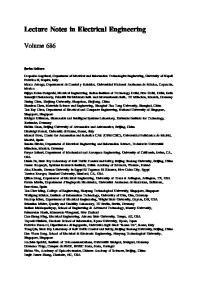Automatic Speech Recognition Systems for the Evaluation of Voice and Speech Disorders in Head and Neck Cancer
- PDF / 607,256 Bytes
- 7 Pages / 600.05 x 792 pts Page_size
- 109 Downloads / 325 Views
Research Article Automatic Speech Recognition Systems for the Evaluation of Voice and Speech Disorders in Head and Neck Cancer Andreas Maier,1 Tino Haderlein,1 Florian Stelzle,2 Elmar N¨oth,3 Emeka Nkenke,2 Frank Rosanowski,1 Anne Sch¨utzenberger,1 and Maria Schuster1 1 Division
of Phoniatrics and Pediatric Audiology, Erlangen University Hospital, Friedrich-Alexander University Erlangen-Nuremberg, Bohlenplatz 21, 91054 Erlangen, Germany 2 Department of Maxillofacial Surgery, Erlangen University Hospital, Friedrich-Alexander University Erlangen-Nuremberg, Gl¨uckstraße 11, 91054 Erlangen, Germany 3 Department of Computer Science, Friedrich-Alexander University Erlangen-Nuremberg, Martensstraße 3, 91058 Erlangen, Germany Correspondence should be addressed to Andreas Maier, [email protected] Received 6 November 2008; Revised 9 April 2009; Accepted 16 June 2009 Recommended by Georg Stemmer In patients suffering from head and neck cancer, speech intelligibility is often restricted. For assessment and outcome measurements, automatic speech recognition systems have previously been shown to be appropriate for objective and quick evaluation of intelligibility. In this study we investigate the applicability of the method to speech disorders caused by head and neck cancer. Intelligibility was quantified by speech recognition on recordings of a standard text read by 41 German laryngectomized patients with cancer of the larynx or hypopharynx and 49 German patients who had suffered from oral cancer. The speech recognition provides the percentage of correctly recognized words of a sequence, that is, the word recognition rate. Automatic evaluation was compared to perceptual ratings by a panel of experts and to an age-matched control group. Both patient groups showed significantly lower word recognition rates than the control group. Automatic speech recognition yielded word recognition rates which complied with experts’ evaluation of intelligibility on a significant level. Automatic speech recognition serves as a good means with low effort to objectify and quantify the most important aspect of pathologic speech—the intelligibility. The system was successfully applied to voice and speech disorders. Copyright © 2010 Andreas Maier et al. This is an open access article distributed under the Creative Commons Attribution License, which permits unrestricted use, distribution, and reproduction in any medium, provided the original work is properly cited.
1. Introduction Head and neck cancer may affect speech and voice. In many cases, surgical treatment will even deteriorate the patients’ ability for oral communication and thus affect their quality of life [1]. So, rehabilitation of dysglossia and/or dysphonia is of outstanding clinical interest. However, assessment of these functional features often lacks objectivity, as it is mainly performed by expert rating which is time- and manpowerconsuming and—although being the gold standard in the clinical field—questionable for scientific purpose. Even speech pathologists with high expertise rea
Data Loading...











